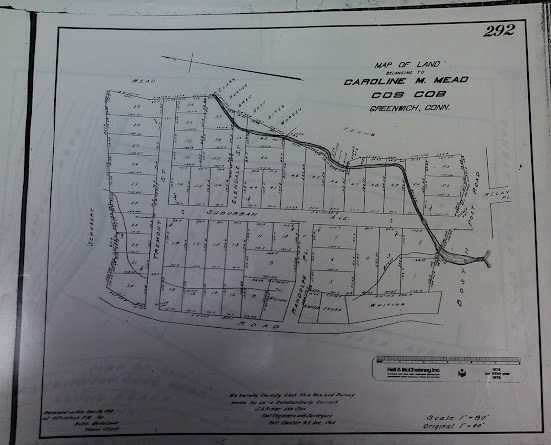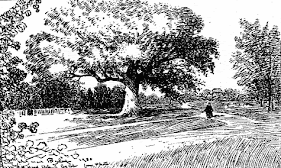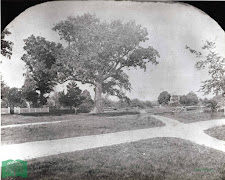Source: Greenwich Press. Friday, February 2, 1912. Pages 1 and 5.
Following are particularly interested excerpts of the history which Mr. Mead has kindly permitted us to reprint:
Indian Massacre
Governor Keift thereupon despatched Captain Underhill to Stamford to get some information in regard to the Indians in this vicinity. He reported verbally to the governor that the Indians were again gathering about Greenwich and that there were five hundred warriors at Petuquapaen. Accordingly, in February, 1644, an expedition of one hundred and thirty men, consisting of Dutch and English under the command of Captain Underhill and Ensign Hendrick Van Dyck, was embarked at Fort Amsterdam for Greenwich. It landed at Greenwich, Old Town (now Sound Beach), where it was obliged to pass the night by reason of a great snow-storm. In the morning the troops marched in a northwesterly direction over stony hills, and in the evening, about eight o'clock, came within a mile of the Indian village, after having crossed two rivers, one two hundred feet wide and three feet deep. Inasmuch as it was too early to make an attack, it was determined to remain there until about ten o'clock. The order was given as to the mode to be observed in making the attack. The hour having arrived they marched forward toward the village, which consisted of three rows of huts set up in street fashion, each eighty paces long, situated in a low recess of the mountain, affording complete shelter from the northwest wind. This village was located on the west side of Strickland Brook, a short distance north of the mill pond at Cos Cob, and the road to North Cos Cob now runs through its site. The moon was then at the full and threw a strong light against the mountain so that many a winter's day was not brighter than that night was.
The Indians were on the alert and prepared to meet their assailants, so the troops determined to charge and surround the village sword in hand. They deployed and advanced rapidly and in a short time one Dutchman was killed and twelve wounded. The Indians were also so hard pressed that it was impossible for one to escape, and in a brief space of time there were counted one hundred and eighty dead outside of the huts. Presently, none dare come forth, but kept within the huts discharging arrows through the holes. Captain Underhill, therefore, resolved to set the huts on fire, and the casting of a firebrand upon the row of dry bark huts and wigwams was but the work of a moment, and the whole village was soon in a blaze.
Whereupon the Indians tried every means to escape, but not succeeding they cast themselves into the flames, preferring to perish by fire rather than by the sword, and among the mass of men, women, and children none were heard to cry out or scream.
According to the reports of the Indians themselves the number then destroyed exceeded five hundred; some say, fully seven hundred, among whom were twenty-five Wappingers, all gathered together to celebrate one of their festivals, from which escaped no more than eight men in all, three of whom were severely wounded. After the fight was finished several fires were built in consequence of the great cold; the wounded, fifteen in number, cared for; and sentinels having
been posted the troops bivouacked for the night.
On the next day the troops started out much refreshed and in good
order, arrived in Stamford in the evening, where they were received in a friendly manner and every comfort extended to them. In two days they reached Fort Amsterdam and a thanksgiving was proclaimed on their arrival for the extermination of the Siwanoys.
Those killed were buried in a large mound on the easterly side of the present road, which was leveled off only a few years ago. The Indians in this part of the country never recovered from the blow. It is true that a few desperate ones hung about the settlements seeking revenge; but they soon went away, and the remainder lived peaceably with the settlers and continued to trade with them.
Old Mead House
Captain Abraham Mead was the eleventh son, each of whom had a sister of Deacon Ebenezer Mead, and was born on the fourteenth day of December 1742. At an early age he was apprenticed to a Dutchman, who was a potter, to learn the potter's trade. This pottery was situated on the westerly side of the Indian Harbor about where the Field House now stands. He was an ingenious by, determined to learn the trade, so he watched his master when he thought himself alone saw the salt thrown into the kiln just before the baking of the clay was completed and the finished articles taken therefrom perfectly glazed, and kept his discoveries to himself. One day the potter, after extinguishing the fires, with his boat and men set sail for New Jersey to obtain a load of clay, leaving the boy in charge. The later spent his time in experimenting, and when they rounded the point on their return they discovered the pottery in full blast. It is said the potter prefaced his exclamation, "He's got it, he's got it," meaning the boy knew the business, with some strong language. The potter, however, did not intend to lose so valuable a man, and after the expiration of the term of his apprenticeship took him in as a partner and later on Captain Abraham Mead succeeded the Dutchman in his business.
He received his early military training in the militia, and at the May Session of the Legislature, 1774, he was commissioned captain of the middle company or train band in the Town of Greenwich.
Immediately after the Lexington Alarm April, 1775, troops were raised for the defense of New York, and Captain Abraham Meads of Horseneck, 9th Regiment, with part of his company, was ordered to march to New York to assist in the defense of that important point. The returns show the time of service to have been eleven days.
In the reorganization of the troops in the year 1776, he was detailed to command the 4th Company of the 1st Battalion, Wadsworth Brigade, raised to reinforce General Washington in New Yorkserved on the Brooklyn front a few days before and during the Battle of Long Island, August 27, 1776; was in the Retreat from New York and was among the four thousand men under General Putnam, who were left as a rear-guard, while the main army under General Washington took a position on Harlem Heights. When Clinton landed in New York September 15, 1777, General Washington sent hurried orders to General Putnam to evacuate the city and join him. Lossing states that General Putnam was ignorant of the routes leading from the city, and that Aaron Burr, one of his aids, led the division through the woods west of Broadway (Bloomingdale Road) to Harlem Heights.
After landing, Howe, Clinton, Tryon and others went to the house of Robert Murray, on Murray Hill, for a short rest and refreshments, as they supposed they had General Putnam hemmed in. The hostess, and unsuspected whig, and a woman of great charm, entertained the officers so graciously, serving them cake, and wine, that she detained them for more than two hours, long enough for the greater part of the forces to escape. They were discovered, however, and a detachment of High infantry was sent in pursuit, which overtook the rear of the American forces in a path extending from the Bloomingdale Road to Harlem Lane, and a warm skirmish took place at the intersection of One Hundredth Street and Eighth Avenue, and Captain Mead and his company came very near being cut off from the main division and captured. He was then posted on Harlem and Washington Heights until the Battle of White Plains, October 28, 1776 in which he and his company were engaged and suffered some loss. After this battle he as in the 9th Regiment, and remained on duty guarding t__ Westchester assumed command of his own company border until January, 1777.
He was appointed a member of the Committee of Safety on the eighth da of December, 1777, and served until the end of the war. He, while acting in this capacity that a price was put on his head, and he was in danger not ____ from recognized foes, but also from the false friends, who might betray him for the reward. One ___ night he went from his home on Held's Point to confer with General John Mead, who was then stationed at Fort Nonsense, which was a short distance above the bridge at Dumpling Pond (now North Mianus). It was unsafe to go by the road, so he took the path along the East Brother Brook. The conference over, he started back, and something strongly impelled him to go some of a different route, so he boldly chose the road. After the close of the war two men, whom he knew, came to him and told him that on that night they were watching for him that on the night they were watching for him on the path, and intended to capture him and deliver him up the the British. He, however, had evaded their evil designs by taking another route home.
On another occasion the commander of the post here warning that a further attempt would be made to take his life, detained four soldiers of the Continental army to serve as his guard; but while on their way to his house on Held's Point, they fell into the ambush designed for Captain Abraham Mead and were all killed and were buried on the point, which place is still marked by a stone.
After the Revolutionary War, he resumed the business of a potter, and made a boat load of pottery and sold it, and used the proceeds to pay off the note on the Second Congregational Church, of which he was a deacon and treasurer for many years. He was chosen town treasurer at the annual town meeting held on the seventeenth day of December 1787, and held the office for ten consecutive years.
T.A. Residence
Revolutionary Period
The author's great-grandfather, Deliverance Mead, heard the firing at Horseneck and climbed on top of his house at Indian Field to see what the trouble was, and he saw the horseman ride down the hill and the smoke from the guns of the tories as they fired at him.
This historic spot is now marked by a monument erected by Putnam Hill Chapter, Daughters of the American Revolution, and unveiled on the sixteenth day of June, 1900.
Colonel Holdridge, who was in command of the Continental soldiers, retreated in an unsoldierly manner to Stanch, while General Putnam only intended that he should retire a short distance. From the account given of this officer (who was a Hartford man) by the Americans, he was totally unfit to be a soldier at all and much less an officer.
The citizens hung about the village as near as they dared, hiding in the swamps and by places during the whole day, taking advantage of every opportunity by some daring feat to _____ _______ and even meantime, separating themselves to squares and pillaged every house in the neighborhood; a large body of them visited Cos Cob where they destroyed the salt works, which were on Bush's Point (now the shipyard), a small sloop and a storehouse.
A party of them also entered the house of Daniel and Joshua Smith, which was situated on the westerly side of North Street near the Second Congregational Church. They found this house deserted by all its inhabitants, excepting a deaf old lady, the mother-in-law of Joshua Smith. As they entered they saw her standing at the head of the stairs. She not being able to hear, disobeyed their orders t come down, which so enraged the soldiers that one of them sprang up the stairs, and cut her down with his sword. After their murder the house was set on fire and burned to the ground. This is said to have been the old house wholly burned by the British during the raid.
The following houses were within the present limits of the Borough of Greenwich at that time.
Colonel Jabez Fitch at the top of Put's Hill.
Captain Israel Knapp, opposite the present Episcopal Church (Knapp Tavern).
An old building near the Soldier's Monument (probably the town hall).
Angell Husted, just west of the Second Congregational Church.
Jared Mead near the corner of Milbank and Putnam Avenues.
Captain John Hobby opposite Sherwood Place.
Colonel Thomas Hobby about opposite Mason Street.
Henry Mead on the corner of Putnam Avenue and Lafayette lace (Mead Tavern).
An old house a little further west.
Captain Matthew Mead next.
Dr. Amos Mead on the brow of the hill opposite the Field Point Road.














































